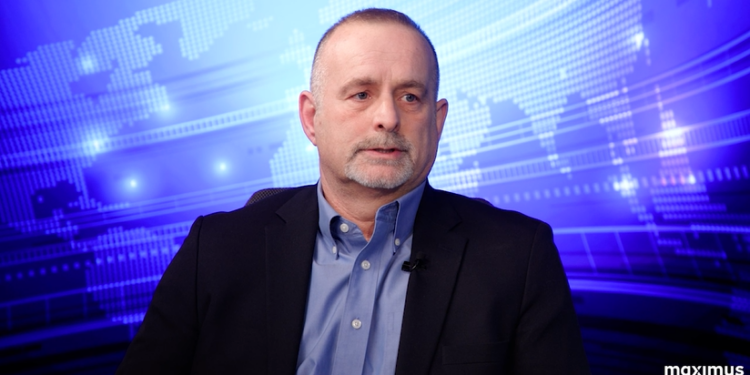For Bryan Martz, the desire to advance the capabilities of the warfighter is, quite frankly, personal.
Having spent 20 years serving in the Army, Martz well understands the challenges of not having updated technology at your fingertips and the critical need to ensure business processing support across the military services to help inform decision-making and streamline operations.
He recalled sometimes thinking, “I can’t get the technology quick enough,” he shared with Federal News Network for our Forward-Thinking Government series.
Today, as vice president of the federal defense market at Maximus, Martz tackles this challenge head on by partnering with Defense Department organizations to develop innovative business processing and technology solutions that support the mission.
We talked with Martz about modernization efforts at DoD, what that landscape looks like now, the benefits being delivered and what still needs to happen.
DoD modernization and the state of readiness today
“If you look at the history of the Defense forces over time, technology has enabled us to minimize the number of forces and support the overall mission needs of DoD, and so to do that, we typically measure our readiness,” he said. “Do we have enough forces? Do we have enough systems … to do the things we’re supposed to from a DoD perspective?”
Paired with that, the department over the last 10 years has focused on executing a customer-centric innovation strategy — and its chief customers are its warfighters, Martz said.
The department is now at a tipping point when it comes to transforming how it tackles mission while also keeping its warfighters and organizations mission-ready, he said. It’s why Maximus is focused on ways it can apply advanced technologies to help enable the services and “empower them to do more with less,” Martz said.
It helps that Maximus is product-agnostic and partners with many leading technology manufacturers, he added. “We’re looking for the right solutions, regardless of the manufacturer, to get that technology to the servicemember, and we’re finding that’s helping to accelerate the modernization process.”
He cited two specific examples:
- For one project, the company worked with one of the military services to plan and develop seamless enterprise IT capabilities supporting real-time collaboration across its network and security operations centers. The goal? Improve the ability to respond proactively.
“The need to operate, defend and respond both before and after threat entities are identified on its network required an infrastructure that supports timely coordination and responses to cyberthreats, which in turn helps assure IT and system resilience for the service,” Martz said.
- For another initiative, Maximus has been helping a Defense organization modernize a highly specialized secure IT environment. “This project will help reduce friction and allow quick data sharing to improve analytics and decision-making based on continuous analytics to ensure the protection of national security,” he said.
DoD modernization and acquisition
One thing that’s helping drive modernization forward are new acquisition strategies. In particular, Martz cited other transaction authorities, or OTAs, which let industry innovate and deliver new solutions rapidly.
He also highlighted an important element that can help improve the outcomes of the acquisition process: time with the customer.
“Spending time with the customer allows us to understand their challenges and identify the most critical areas that require support for the mission. We do that with a service delivery mentality,” he said. These conversations ensure that Maximus can develop tailored solutions against clearly articulated success factors and help ensure mission readiness, Martz added.
DoD modernization, data overload and AI
Despite technological and acquisition advances, information overload remains a struggle across DoD’s Fourth Estate agencies as well as its military services, Martz said.
Given his 20 years with the Army, followed by 20 years in the federal technology industry, Martz said he well understands the challenges of vetting access to data, culling the appropriate data and then processing that data in a timely fashion. “That’s a huge challenge,” he said.
But transformative technologies — everything from data analytics and cloud to robotic process automation and artificial intelligence — are making headway. Particularly cloud and AI are “really empowering the workforce, even in secure environments, to be much more effective,” Martz said.
He shared the example of DoD software armories and factories developing ways to use AI to help identify transformation requirements as they arise.
With programs like the Air Force’s Platform One and Navy’s Project Overmatch, the services “have developed capabilities to do DevSecOps for applications and common services and get them out to the fleet or the forces quickly. The challenge with that is: Are they secure? Can they deploy quickly?” Martz said, adding that both are key factors to secure successful deployment and use.
If DoD and its industry partners can apply AI in the development process and gauge how a program or project is operating and supporting mission readiness, then they can capture success metrics. And when the AI model does that and steers that application or service to an operational unit automatically, without having to have a servicemember in the middle, Defense organizations will be gaining traction on modernization, Martz said.
“I’m really excited about that aspect of it, especially from an AI perspective.”
Discover more ways to improve, secure and transform your federal operations in our Forward-Thinking Government series.
Copyright
© 2025 Federal News Network. All rights reserved. This website is not intended for users located within the European Economic Area.







